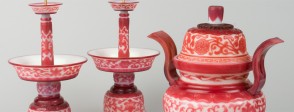Explore aspects of China’s trade and cultural contacts with other cultures using the British Museum website www.earlyimperialchina.co.uk. In particular, use the sections accessed through the notebooks, the poster, the camel, the globe and the bookcase.
The following questions aim to encourage broader historical enquiry.
China has been a major world economic power for much of the last 2000 years with connections across Asia and Europe. Investigate the following historical figures from China and other countries who played major roles in the fields of culture, religion and commerce:
- from China: Xuanzang; Zheng He
- from Europe: Marco Polo; Matteo Ricci; Giuseppe Castiglione; George Macartney
- from the Arab world: S’ad ibn Abi Waqqas; Ibn Battuta
Compare the shape of the incense burner in the altar set with the ancient bronze vessel in For the classroom. Similar sets are also seen in Daoist and Confucian temples and in the great imperial ritual sites such as the Temple of Heaven. Use the photo in For the classroom to explore the use of such sets. Investigate the way religions adapt to the different countries and cultures they are transmitted to. Think of the different Christian churches across the world and the differing forms of Buddhism and Islam across Asia. Are there any common features in this adaptation across the religions?
Over centuries China had a monopoly on three trade goods of which it alone had the secret of production and which were, in succession, the source of its great wealth: silk, porcelain and tea. Trade monopolies cannot last forever, so consider the factors that bring them to an end. Explore lessening of demand, development of alternatives, the leaking of the secrets of production and manufacture in other countries. Find examples from countries other than China.
Choose one of the three commodities from above and research examples from different periods to see how they developed. Where were their main markets and where and when did they start to be produced outside China? Look at the quest to discover the secret of porcelain manufacture in Europe or the British development of a tea industry in India. With reference to the latter, research the botanist and plant hunter Robert Fortune.
Faced with a huge trade imbalance with China over tea, Britain adopted a two-pronged approach to correcting this. One was to discover the secret of tea manufacture and the other was to develop a rival commodity to trade with China. Investigate the use of British possessions in India to mass produce opium; how the trade was carried out; and its far-reaching effects on the economic and political affairs of China. See Object file: A Wedgwood tea set for more on the Opium Wars.
Most of the great civilisations of world history increased their power and wealth through invasion and colonisation. Choose examples from different periods such as the Egyptians, the Babylonians, the Persians, the Romans, the French, the Spanish and the British to investigate the process of expansion and decline of great powers.
Imperial China, by contrast, with a few exceptions mainly around their western borders with the nomadic peoples of central Asia, or when they were themselves invaded by the Mongols, did not maintain their power by invasion. What were the factors that enabled them to do this, and what effect did this have when they finally came into conflict with other powers that had developed their empires through military and naval might?
The following two activities are suitable for younger students.
Partially or completely cover coloured plastic tumblers in a thin layer of modelling clay of a contrasting colour. Tell the students to imitate the technique of overlay glass by using modelling tools to cut away areas of the clay to create a raised design as on the altar set. Students can create their own design or copy elements of the patterns on the altar set. If the tumblers are too difficult for the age group, a simple plaque can be made out of two layers of contrasting modelling clay, and the same technique employed.
Explore the photo of a shrine in For the classroom. The class can create their own miniature Buddhist altar using ideas from here: http://www.wikihow.com/Create-a-Simple-Buddhist-Shrine. The central Buddha image could be a plaque made using the technique described above.


